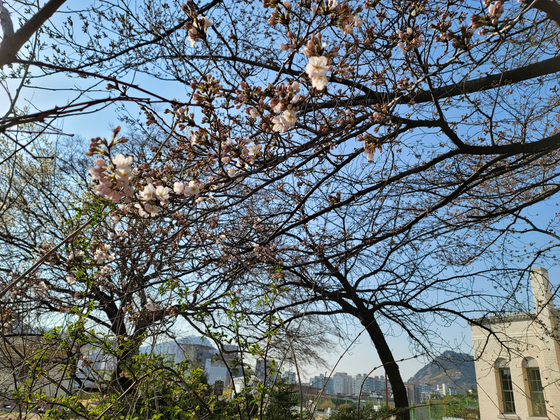
Cherry blossoms blooming on the observation tree at the Seoul Meteorological Observatory. Meteorological Agency
It was confirmed that cherry blossoms are already blooming in Seoul as days warmer than normal continued. This is the earliest time since cherry blossoms were observed in 1922.
The Meteorological Administration announced that the cherry blossoms in Seoul this year have bloomed on the 24th. It is the fastest since the Meteorological Administration has observed cherry blossoms in Seoul since 1922. It is three days faster than last year (March 27), which was the fastest in history, and bloomed 17 days earlier than normal (April 10).
Cherry blossoms in Seoul are based on the Yoshino cherry trees designated at the Seoul Weather Station in Jung-gu, Seoul. A multi-flowered plant that has many flowers in one individual, such as cherry blossoms, is considered to be blooming when three or more flowers are in full bloom on one arbitrary branch in one tree.
On the other hand, the observation tree, which is the standard for Yunjung-ro, Yeouido, a representative cherry blossom complex in Seoul, has not yet bloomed. The Meteorological Administration has designated Yunjung-ro in Yeouido as a community of cherry blossoms since 2000, and has observed three trees in front of the six gates of the National Assembly. In the case of last year, cherry blossoms were also observed in Yunjung-ro on March 30, three days later than the Seoul Meteorological Observatory.
The temperature in March is as high as 5.1 degrees… Daylight hours also increase

The date of flowering of cherry blossoms in Seoul in the last 10 years. Graphic = Reporter Jaemin Shin [email protected]
The reason the cherry blossoms bloomed earlier than normal this year is because the average temperature in February and March is higher than normal and the sunshine hours are higher than normal.
According to the Meteorological Administration, the average temperature in March was 8.3 degrees as of the 23rd. It is a whopping 5.1 degrees higher than the average value (3.2 degrees). Last month also averaged 2.7 degrees, 0.4 degrees higher than the average value (2.3 degrees).
Choi Jeong-hee, the secretary of the Meteorological Administration’s Climate Change Monitoring Division, said, “As the cold of the Arctic is not coming down and staying in Siberia, the warm south wind has flowed in a lot, so the overall temperature remains high.”
Daylight hours in March also totaled 158.5 hours, 20.2 hours longer than the normal year (138.3 hours). Last month, it was 181 hours, 17.7 hours more than the normal year (16.3.3 hours).
The Meteorological Administration provides the state of flowering of major cherry blossoms and azalea communities across the country through Weather Nuri.
Reporter Chun Kwon-pil [email protected]
![]()
